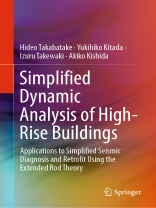This book presents a simple analytical method based on the extended rod theory that allows the earthquake resistance of high-rise buildings to be easily and accurately evaluated at the preliminary design stage. It also includes practical software for applying the extended rod theory to the dynamic analysis of actual buildings and structures.
High-rise buildings in large cities, built on soft ground consisting of sedimentary rock, tend to have low natural frequency. If ground motion due to an earthquake occurs at distant hypocenters, the vibration wave can be propagated through several sedimentary layers and act on skyscrapers as a long-period ground motion, potentially producing a resonance phenomenon that can cause severe damage. Accordingly, there is a pressing need to gauge the earthquake resistance of existing skyscrapers and to improve their seismic performance.
This book was written by authors who have extensive experience in tall-building seismic design in Japan. The software included enables readers to perform dynamic calculations of skyscrapers’ resistance to vibrations. As such, it offers a valuable resource for practitioners and engineers, as well as students of civil engineering.
Table des matières
Structural Properties of High-rise Buildings.- Earthquake Response Analysis of High-rise Buildings.- Measures for the Long- period Ground Motion.- Equivalent Rod Theory.- Analysis of High-rise Buildings by the Rod Theory.- Analysis Example by the Rod Theory.- Application SSD, Designed for Response Analysis Using the Rod Theory.- Analysis Considering Soil-Structure Interaction.- Amplification of Earthquake Ground Motions by Surface Ground.- Fundamental Information Notes of Structural Design.- APPENDIX.
A propos de l’auteur
Hideo Takabatake was a Professor, Director and Advisor at the Institute of Disaster and Environmental Science at Kanazawa Institute of Technology, Japan until 2018. He is currently a visiting professor and emeritus professor at Kanazawa Institute of Technology. He formerly served on the board of directors of the Architectural Institute of Japan (1996 – 1997). He has authored several books, including Simplified Analytical Methods of Elastic Plates, published by Springer, and has published many papers in leading international journals on various subjects related to architectural structure.
Yukihiko Kitada is a Professor (emeritus) at Ishikawa National College of Technology, Japan. He has excellent ability in analysing structures and has outstanding knowledge in program development to realize it.
Izuru Takewaki is a Professor at the Department of Architecture and Architectural Engineering, Kyoto University. He is a former Vice President of the Architectural Institute of Japan (2013 – 2015), an Associate Editor of Soil Dynamics and Earthquake Engineering and a Field Chief Editor of Frontiers in Built Environment (Switzerland). He has published several monographs from Springer and others, and many papers in leading international journals on earthquake structural engineering.
Akiko Kishida is an Assistant Professor at the Department of Architecture, Kobe University Graduate School of Engineering. She is a researcher on the interaction problem of ground and structure in buildings and has outstanding knowledge in analysis and program development for static and dynamic problems.












